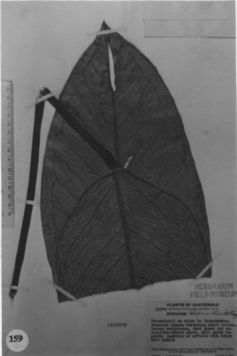




Anthurium retiferum Standl. & Steyerm.,
Publ. Field Mus. Nat. Hist., Bot. Ser. 23: 211. 1947. TYPE: Guatemala. Huehuetenango:Sierra de los Cuchumantes, Cerro Huitz, between Nimahuitz and Yolhuitz, elev. 1,500-2,600 m, Steyermark 48621 (F, holotype).
Terrestrial or epiphytic.
LEAVES with petioles 26-37 cm long, 6-8 mm diam., flattened adaxially with sharp margins, terete abaxially; geniculum 1.5 cm long, dull purple; blades coriaceous, narrowly to broadly oblong-elliptic, 33-47 cm long, 12-22 cm wide, broadest just below middle, short-acuminate at apex, truncate to round at base; both surfaces semiglossy; midrib raised above and below, red-violet above; basal veins 1-2 pairs; primary lateral veins 6-12 per side, departing midrib at 40°-50° angle, equally as prominent as the basal veins, all veins drying prominently raised above and below; collective vein arising from one of the primary lateral veins, ca. 1.5 cm from margin.
INFLORESCENCE with peduncle 19 cm long, 4 mm diam., peduncle and spathe red-violet; spathe lanceolate, reflexed, ca. 6.5 cm long, 1.3-1.5 cm wide, cuspidate-acuminate at apex; spadix sessile, dull purple, 8.5-9 cm long, 4-5 mm diam. at base, 3-4 mm diam. at apex.
INFRUCTESCENCE unknown. Fig. 159.
Anthurium retiferum is endemic to Guatemala in the Sierra dc
los Cuchumantes in the Department of Huehuetenango at 1,500 to 2,600 m.
The species is in section Belolonchium and is characterized
by its sessile, purplish spadix and its coriaceous, oblong-elliptic leaf
blades with the primary lateral veins equally as prominent as the basal
veins and with prominently raised tertiary veins (on drying).
The species is perhaps closest to A. parvispathum
but differs in having much broader leaves and in having the tertiary veins
prominently raised on drying.
 |
GUATEMALA. HUEHUETENANGO: Cerro Huitz, between Nimahuitz and Yolhuitz,
Steyermark 48621 (F); Cerro Negro, E of Las Palmas, Steyermark 51676 (F,
US).